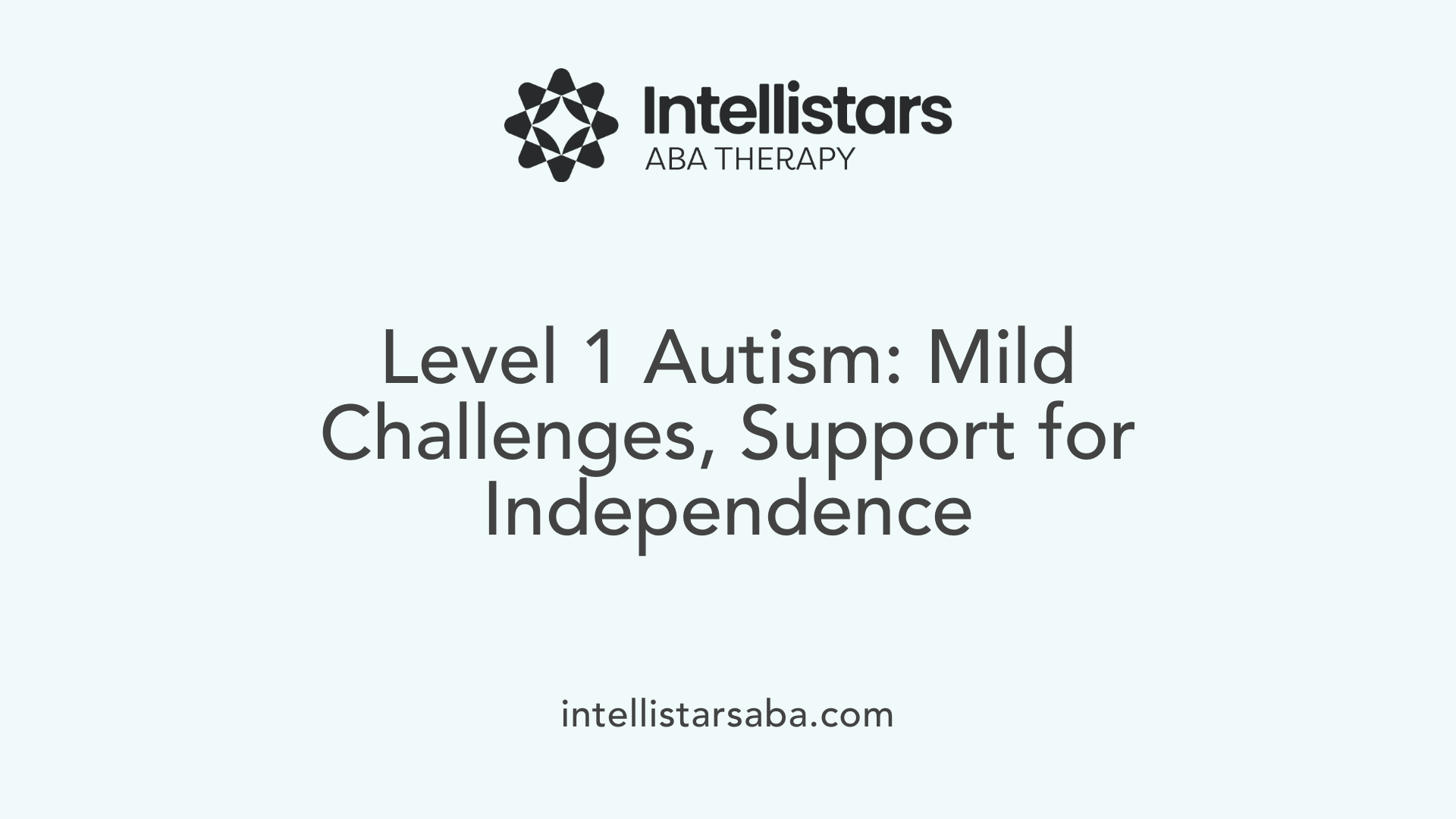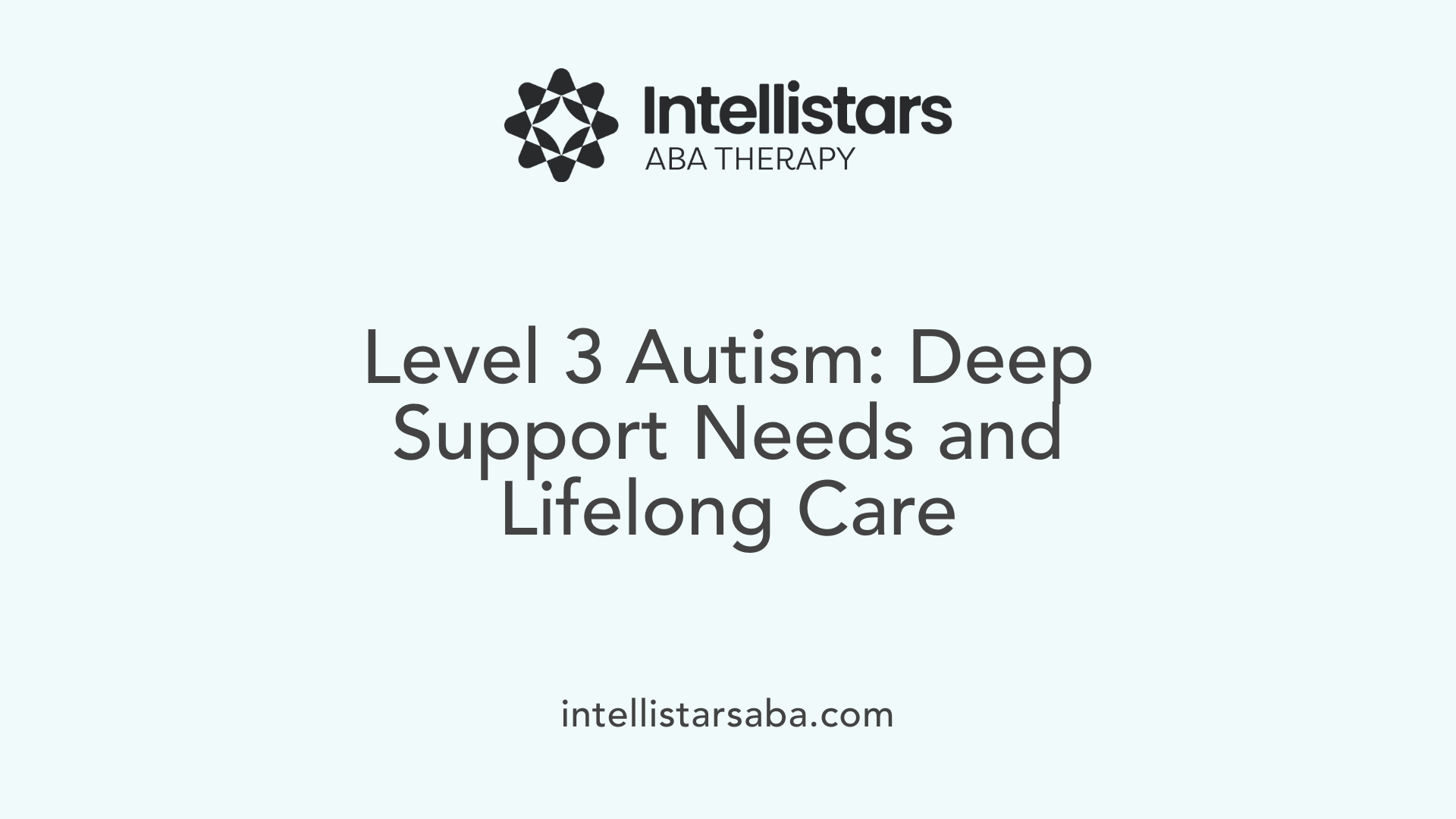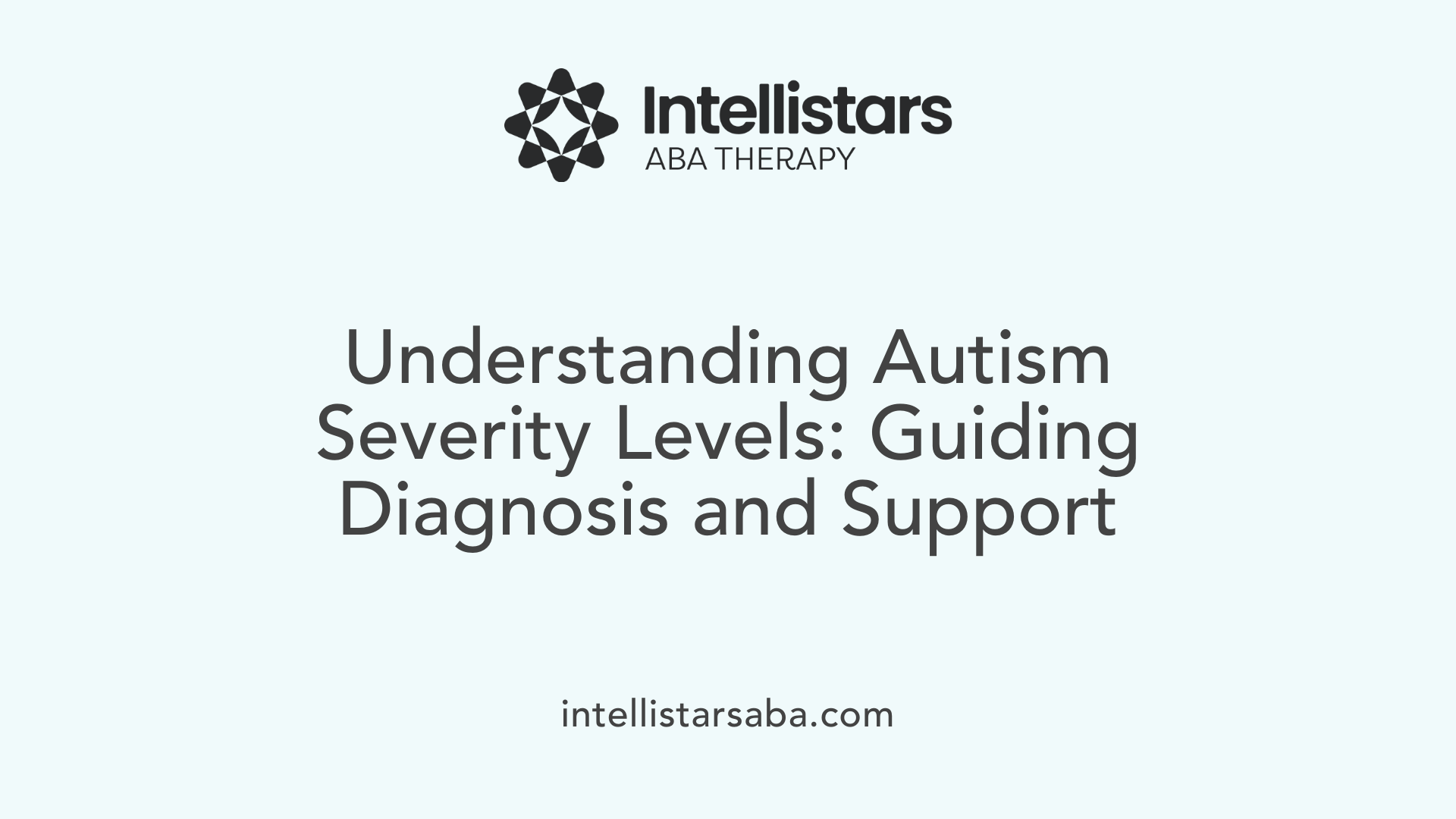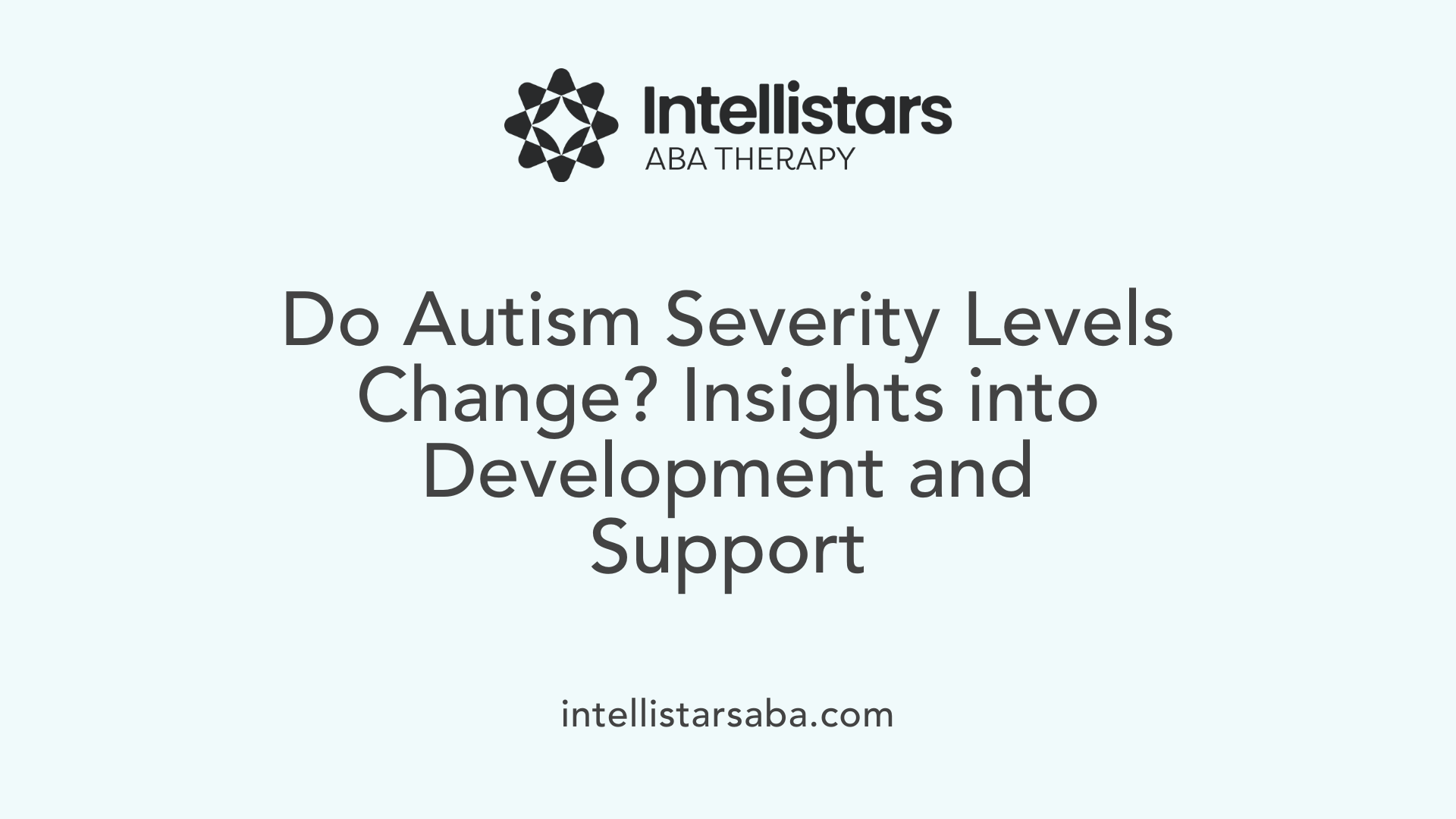A Closer Look at Autism Severity and Support Needs
Autism Spectrum Disorder (ASD) is a complex and varied neurodevelopmental condition characterized by differences in social communication, behaviors, and adaptability. The DSM-5 classifies ASD into three severity levels—Level 1, Level 2, and Level 3—based on the support each individual needs to function effectively. This classification helps clinicians, educators, and families tailor interventions and support systems to improve quality of life and independence. In this article, we explore each autism level's unique characteristics, implications for diagnosis and treatment, and how these levels can evolve over time.
Autism Spectrum Disorder Severity Levels and Characteristics
- DSM-5 classifies ASD into three levels based on support needs: Level 1, Level 2, and Level 3.
- Level 1 autism indicates mild symptoms with individuals often having average or above-average intelligence and the ability to communicate effectively.
- Level 2 autism involves significant communication delays, repetitive behaviors, and a need for substantial support in daily routines.
- Level 3 autism is marked by severe impairments in communication, intense repetitive behaviors, and lifelong, widespread support requirements.
- Support strategies increase with severity, ranging from social skills training at Level 1 to intensive therapies at Level 3.
- Autism severity levels can change over time with early and consistent intervention and support.
- Diagnosis involves evaluating social, communicative, and behavioral challenges, with severity guiding treatment planning.
- Interventions are tailored to severity, with less intensive therapies for Level 1 and comprehensive, multidisciplinary approaches for Level 3.
- Autism severity is not fixed; improvements can lead to reassessment and reclassification, especially with early intervention.
- A holistic, personalized approach beyond severity levels is essential for effective support and improved quality of life for individuals with ASD.
1. Level 1 Autism: The Mild Category with Support Needs

What are the autism spectrum disorder severity levels and how are they classified?
The DSM-5 classifies autism spectrum disorder (ASD) into three levels based on the support required for daily living. These are Level 1, Level 2, and Level 3. Level 1, termed 'requiring support,' involves some noticeable difficulties in social communication and inflexibility but generally allows individuals to function with minimal assistance. Level 2, requiring substantial support, features more evident challenges in social interactions and behavior, often affecting daily routines. The most severe, Level 3, requires very substantial support due to severe impairments in communication, social engagement, and behavior.
Characteristics of Level 1 Autism
Individuals at this level often exhibit mild symptoms and high verbal intelligence. They can usually communicate effectively but may struggle with social cues and maintaining relationships.
They tend to prefer routines and may become anxious or distressed when routines are disrupted. Their behavior might include some repetitive actions or restricted interests.
Often, these individuals are capable of independent living with the right supports, including educational accommodations or social skills coaching.
Symptoms associated with Level 1
- Difficulties initiating social interactions but able to respond when engaged.
- Challenges interpreting social cues, leading to misunderstandings.
- Preference for routines, with trouble adapting to changes.
- Inflexible thinking patterns that can hinder independence.
- Possible sensory sensitivities.
- Generally good verbal skills and average or above-average intelligence.
Support and intervention strategies for Level 1
Support varies based on individual needs but often includes:
- Social skills training to enhance communication and relationship-building.
- Organizational assistance, such as visual schedules or planners.
- Educational support tailored to strengths and weaknesses.
- Behavioral therapy to address inflexible and repetitive behaviors.
- Environmental modifications to reduce sensory overload.
- Summer programs, peer modeling, and community integration activities.
Early detection and personalized intervention can foster greater independence and enhance quality of life for individuals with Level 1 ASD. Tailoring support to individual needs is essential since some may require ongoing assistance, while others thrive with minimal support tailored to specific challenges. The focus is on leveraging strengths while addressing challenges associated with social communication and inflexibility.
2. Moderate Challenges: Understanding Level 2 Autism

What are the characteristics and symptoms associated with each autism severity level?
Autism Spectrum Disorder (ASD) manifests in varying degrees of severity, which influence both the behavioral profile of individuals and the support they require. Level 2 autism, classified as requiring substantial support, features notable challenges across social communication and behavior.
Individuals with Level 2 ASD often have significant delays in both verbal and non-verbal communication. They may use simplified speech, such as short sentences or echolalia, and struggle to understand or use non-verbal cues like gestures and facial expressions. Their social interactions tend to be limited, with difficulties initiating and maintaining conversations.
Repetitive behaviors are more evident at this level. These can include intense interests in specific topics, inflexible routines, and disturbances in adapting to changes. These behaviors often interfere with daily functioning and may cause distress when routines are disrupted.
The severity of symptoms at this level affects everyday life, making routine activities and social integration more challenging. Support needs are substantial, involving interventions tailored to improve communication, social skills, and adaptive behaviors.
Key features of Level 2 Autism
| Feature | Description | Impact |
|---|---|---|
| Communication Difficulties | Limited speech, echolalia, limited non-verbal cues | Challenges in expressing needs, understanding social cues |
| Social Interaction | Restricted interactions, difficulty forming relationships | Social isolation and difficulty in group settings |
| Repetitive Behaviors | Restricted interests, strict routines, sensory sensitivities | Disruption of daily activities and distress when routines change |
| Support Needs | Substantial assistance in daily routines and communication | Dependence on caregivers for daily functioning |
Implications for support and treatment
Interventions for Level 2 ASD focus on enhancing communication skills, reducing problematic behaviors, and increasing independence. Speech therapy can help develop functional language skills, while occupational therapy addresses sensory issues and adaptive behaviors.
Behavioral interventions, such as Applied Behavior Analysis (ABA), are effective in decreasing repetitive behaviors and promoting skill development. Educational strategies often include structured routines, visual supports, and social skills training.
Supporting individuals at this level also involves caregivers and educators working closely to create consistent routines and clear communication methods. Early and ongoing intervention can significantly improve quality of life and aid in developing greater functional independence.
More information and intervention options
For detailed strategies tailored to Level 2 autism symptoms and interventions, consider research on behavioral therapies, communication supports, and educational accommodations.
3. Severe Impairments: The Most Critical Level of Autism

Core traits and behaviors of Level 3 Autism
Level 3 autism is characterized by profound challenges in communication, social interaction, and behavior. Individuals at this level often have severe impairments in verbal and nonverbal communication. Some may be non-speaking or have minimal speech, making it difficult for them to express needs or feelings.
Repetitive behaviors are intense and pervasive, including motor movements like hand-flapping, rocking, or spinning. These behaviors may be self-injurious or highly disruptive, especially when routines are suddenly changed. Sensory sensitivities are common, leading to distress from loud noises, bright lights, or certain textures.
Socially, people with Level 3 autism typically show limited or no response to social overtures and have minimal interest in initiating interactions. They generally do not meet developmental milestones related to eye contact or shared attention, which are foundational for social learning.
Impact on daily living and independence
The daily life of individuals with Level 3 autism is significantly affected. Many require lifelong support for basic activities such as self-care, including feeding, dressing, and hygiene. They often need supervision to prevent self-harm or manage severe behaviors.
Educationally, they benefit from tailored interventions like intensive behavioral therapies and communication aids. The ability to develop adaptive skills varies, but overall, independence in daily routines remains limited.
The high support needs also extend to environmental modifications—such as sensory-friendly spaces—and assistive technologies to improve communication and reduce distress.
Approaches to support and therapy
Support strategies for Level 3 autism focus on maximizing quality of life and promoting as much independence as possible. Early intervention programs, especially those implementing Applied Behavior Analysis (ABA), aim to improve communication, social skills, and adaptive behaviors.
Augmentative and Alternative Communication (AAC) devices, such as picture exchange systems or speech-generating devices, are vital for non-verbal individuals.
Occupational therapy helps manage sensory sensitivities and develop motor skills, while speech therapy assists with any residual communication abilities.
Behavior management techniques focus on reducing challenging behaviors and teaching functional skills. Additionally, creating predictable routines and sensory-friendly environments helps minimize distress.
While the condition is lifelong, consistent, tailored support can improve comfort, reduce behaviors that interfere with functioning, and foster moments of engagement.
Can autism severity levels change over time?
Autism severity levels can change over time, especially with early and consistent intervention. While autism is a lifelong condition, individuals—particularly children—may experience improvements in communication, social skills, and behavior that can reduce the level of support needed. For example, children with Level 3 autism, characterized by severe difficulties, may make progress that allows them to be reassessed at a lower support level. However, the degree of change varies widely among individuals and depends on factors such as the intensity of therapy, early diagnosis, and personal strengths. Overall, although autism severity is generally considered stable, significant improvements are possible with appropriate and tailored interventions.
What are the autism spectrum disorder severity levels and how are they classified?
The DSM-5 categorizes autism spectrum disorder (ASD) into three levels, which reflect the amount of support an individual needs for daily functioning. These levels are intended to help describe the severity of challenges faced and guide treatment planning.
Level 1, known as 'requiring support,' involves noticeable but manageable impairments in social communication and inflexibility. Individuals at this level may have some difficulty initiating social interactions or understanding social cues but can often develop support strategies to help them function better.
Level 2, called 'requiring substantial support,' features more pronounced difficulties. People at this stage tend to have marked deficits in social engagement, may use limited verbal or non-verbal communication, and often display repetitive behaviors that interfere with their daily life.
Level 3, identified as 'requiring very substantial support,' describes individuals with severe impairments. They typically have minimal or no verbal communication, exhibit intense repetitive behaviors, and experience significant challenges in social interaction. Their behaviors and needs markedly impact all areas of daily life.
It is important to note that these levels are based on the support needs of the individual, not solely on the severity of core symptoms like social deficits or restricted behaviors. An individual’s support needs might evolve over time with appropriate interventions and support systems.
Overall, the classification aims to provide a clearer understanding of the variation within ASD, allowing for tailored interventions that match each person’s specific needs.
What are the characteristics and symptoms associated with each autism severity level?
Individuals with autism spectrum disorder (ASD) exhibit a range of traits and symptoms that vary by severity level.
Level 1 (requiring support) involves noticeable challenges in social communication. Individuals often find it difficult to initiate interactions and may respond atypically to social overtures. They might misread social cues and show inflexible behaviors that can hamper their ability to function independently. Despite these challenges, they usually have average or above-average intelligence and can develop support strategies to improve their social skills.
Level 2 (requiring substantial support) individuals experience more significant difficulties in social interaction. They often speak in simple sentences or may be minimally verbal and may have trouble understanding nonverbal cues. Repetitive behaviors and restricted interests become more evident and are more disruptive to daily activities. They require substantial support for communication, daily living skills, and managing behaviors.
Level 3 (requiring very substantial support) represents the most severe end of the spectrum. Individuals at this level may be nonverbal or have severe speech impairments. Their social responses are limited, and they may demonstrate intense repetitive behaviors that significantly interfere with daily life. These individuals often face challenges with self-care and may engage in behaviors like self-injury or aggression. They require ongoing, comprehensive support to manage their needs.
Across all levels, core symptoms include difficulties in social interactions, restricted interests, and repetitive behaviors. The severity influences daily functioning, independence, and the type of support necessary to improve quality of life.
How do autism severity levels affect diagnosis, support, and treatment options?

How do autism severity levels influence the diagnosis process?
The severity of autism spectrum disorder (ASD), as categorized by the DSM-5, plays a significant role in shaping the diagnostic approach. Clinicians evaluate social communication impairments and repetitive behaviors to determine whether an individual falls into Level 1, Level 2, or Level 3. These levels reflect the amount of support the individual needs to function effectively in daily life.
Diagnosis involves detailed assessments, including developmental history, standardized tools such as ADOS and ADI-R, and observation by multidisciplinary teams. While these assessments identify the presence of ASD and its severity, they do not capture all aspects influencing support needs, especially co-occurring conditions.
How do severity levels impact support needs?
Support requirements increase with severity levels. Individuals with Level 1 ASD often have milder impairments, requiring minimal support primarily for social understanding and organization. In contrast, Level 2 individuals need substantial assistance with communication, daily routines, and social adaptations. Those with Level 3 autism may require intensive, lifelong support for communication, self-care, and managing behaviors.
The support system must be tailored. For example, Level 3 individuals may benefit from intensive interventions like 24-hour supervision, specialized communication tools, and behavioral therapies.
How do treatment options vary by severity?
Treatment approaches are adapted based on severity. Early intervention is crucial across all levels but differs in intensity and focus. For Level 1 ASD, therapies like social skills coaching and behavioral interventions often suffice.
For Level 2, therapies may include augmentative and alternative communication (AAC), targeted behavioral strategies, and support for adaptive skills. Level 3 cases typically require comprehensive, multidisciplinary interventions such as intensive behavioral therapy, sensory integration, medical management, and extensive support for daily activities.
While severity guides intervention planning, it is not the sole factor. Co-occurring conditions like intellectual disability, anxiety, or sensory processing issues can significantly influence treatment design.
The importance of a multidimensional approach
Effective diagnosis and treatment go beyond severity levels. A holistic view considers the individual's adaptive behaviors, strengths, challenges, co-occurring conditions, and environmental factors. This ensures personalized support plans that improve quality of life and functional independence.
In summary, severity levels provide valuable guidance on the support required, influence the diagnostic process, and shape treatment strategies. Nonetheless, a comprehensive, personalized approach remains essential to address each person’s unique needs.
Can autism severity levels change over time?
 Autism severity levels are not fixed and can change over time, especially when early and consistent intervention is provided. While autism is a lifelong condition, the level of support an individual needs may vary as they grow and develop.
Autism severity levels are not fixed and can change over time, especially when early and consistent intervention is provided. While autism is a lifelong condition, the level of support an individual needs may vary as they grow and develop.
For many children and even adults, targeted therapies and support strategies can lead to improvements in communication, social skills, and behavior management. This can sometimes result in a reassessment that indicates a lower level of support is now sufficient.
For example, a child initially classified as Level 3 autism, which involves severe challenges in verbal and nonverbal communication and requires very substantial support, might make gains through therapies like speech and occupational therapy. These improvements can sometimes allow for a reclassification to Level 2 or even Level 1, indicating a reduced need for daily support.
However, the degree of change varies widely among individuals. Factors influencing progress include the timing of diagnosis, the intensity and type of interventions, personal strengths, co-occurring conditions, and environmental support.
Overall, although most experts consider autism severity to be relatively stable over time, significant progress and adaptation are possible. Support plans can be adjusted to reflect the current needs of the individual, emphasizing a dynamic approach rather than a fixed diagnosis.
Navigating the Spectrum: Tailoring Support and Expectations
Understanding the three levels of autism provides essential insight into the support each individual may need. While autism is a lifelong condition, targeted interventions and early support can improve functioning and quality of life. Recognizing that severity levels can evolve emphasizes the importance of personalized, adaptable care. By focusing on individual strengths and needs, families, educators, and healthcare professionals can foster environments that promote growth, independence, and well-being for everyone on the autism spectrum.
References
- ASD levels of severity - Autism Speaks
- Clinical Testing and Diagnosis for Autism Spectrum Disorder - CDC
- The 3 Levels of Autism Explained - Lane Regional Medical Center
- Understanding the Levels of Autism - Child Mind Institute
- Approach to autism spectrum disorder: Using the new DSM-V ...
- Levels of Autism: An Explanation - Psychiatry Advisor
- What Are the 3 Levels of Autism Spectrum Disorder? - Verywell Health
- Level 3 Autism: Guide to Treatment, Daily Life & Prospects - Blue ABA
- Autism severity and its relationship to disability - PMC






